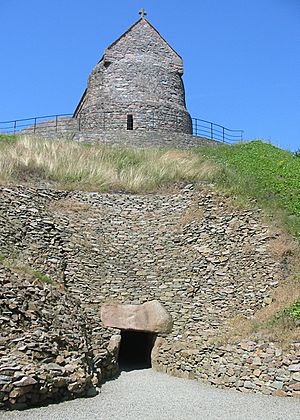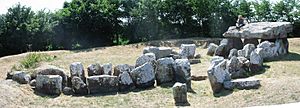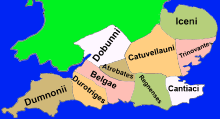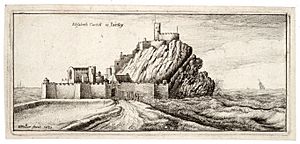Archaeology of the Channel Islands facts for kids
Archaeology is like being a detective for the past! It's the study of human history through digging up old things people left behind. In Jersey, groups like the Société Jersiaise and Jersey Heritage help promote this exciting work. In the Bailiwick of Guernsey, La Société Guernesiaise, Guernsey Museums, and the Alderney Society do similar work. Even World War II history is explored by Festung Guernsey.
Archaeologists on the islands often give talks about their discoveries. They also need helpers and volunteers for their summer digs, which are like treasure hunts for history! People first became interested in the islands' archaeology way back in the 1500s. By the 1700s, articles were being published with pictures of interesting old sites.
Contents
- Archaeology in Jersey
- Archaeology in Guernsey
- How Sea Levels Changed the Channel Islands
- Key Archaeology Sites and Finds from Different Time Periods
- Palaeolithic Period (Old Stone Age)
- Ice Age Period (14,000 BC – 12,000 BC)
- Mesolithic Period (Middle Stone Age) (12,000 BC to 4,500 BC)
- Neolithic Period (New Stone Age) (4,500 BC – 1,800 BC)
- Bronze Age (1,800 BC – 1,100 BC)
- Iron Age (1,100 BC – 500 AD)
- Early Middle Ages (450 AD to 1000 AD)
- High Middle Ages (1000 AD - 1300 AD)
- Late Middle Ages (1300 AD to 1500 AD)
- Early Modern Period (1500 AD – 1750 AD)
- Late Modern Period (1750 AD to 2000 AD)
- Museums
- See Also
Archaeology in Jersey
The Société Jersiaise started in 1873. Over the years, this group has bought important archaeological sites to protect them. Two of the most important sites are La Hougue Bie, bought in 1919, and La Cotte de Saint-Brélade, bought in 1955.
The Jersey Museum was started by the Société Jersiaise in 1893. Its large collections are now looked after by Jersey Heritage. Jersey Heritage is a local charity that began in 1981. It works to protect and share the island's rich history and culture.
Sometimes, when new buildings are planned, archaeologists need to check the site first. This helps make sure no important historical finds are missed. In 2014, 24 building plans needed this kind of archaeological check. Jersey Heritage also tries to get people involved. For example, in 2014, the Société Jersiaise held many archaeology events. These were part of a big festival for British archaeology.
Archaeology in Guernsey
Guernsey Museums have many archaeological collections. They also have old finds, especially about 250 prehistoric stone tools. These tools were mostly collected by the Lukis family in the 1830s and 1840s.
Guernsey has its own States Archaeologist. This person either leads digs or approves other archaeologists who want to work there.
Some long-term projects have included:
- Herm: Island of the Dead? This project by Durham University looks at the ancient landscape of Herm.
- Stepping Stones to the Neolithic? This project studies how people moved between islands. It looks at the 'western seaways' of Britain from 5,000-3,500 BC. Universities of Reading, Southampton, and Liverpool are working on it.
- The Alderney Nunnery project, led by Guernsey Museums.
Archaeology under the sea is also protected by laws. You can see displays of shipwreck finds at the Shipwreck Museum at Fort Grey. There is also a Maritime Museum at Castle Cornet.
The “Guernsey Sites and Monument Record” is a list of all known archaeological sites. It also includes places where old items have been found in Guernsey. This record is kept up-to-date by the Archaeology Officer.
Sadly, some early archaeological evidence on Alderney has been lost. This happened during Victorian times when people were quarrying and building forts. Later, German occupiers also destroyed some sites. However, the Alderney Society is very active and has an excellent museum.
How Sea Levels Changed the Channel Islands
Understanding how sea levels changed is very important for studying the islands' early history. The Channel Islands were never covered by ice. However, they were shaped by rivers like the Seine and Ay.
Over the last million years, sea levels have changed a lot. Sometimes they were much higher, and sometimes much lower. About 800,000 years ago, sea levels were probably 35 meters higher than today. This changed over time as ice formed elsewhere and the land rose.
Around 20,000 years ago, during a very cold period, the sea level was about 100 meters lower than now. This meant the coastline was about 120 km west of the islands! The islands were connected to mainland France. Then, the sea level rose quickly. By 9,400 BC, the sea was close to where it is now. But the islands were still connected to France.
Alderney likely became a separate island first. The landmass of Guernsey and Sark separated around 9,200 BC. Guernsey, Sark, and Herm became separate islands around 5,000 BC. Jersey finally separated from the French coast about 1,000 years later. Some old stories say a land bridge between Jersey and France lasted until a big storm in 709 AD. This same storm also separated Herm from Jethou.
The islands have old beaches that are now higher than the sea. One is 8-9 meters above current sea levels from about 130,000 years ago. There is also evidence of a forest in Vazon Bay, Guernsey, that is now under the sea. The very high tides and strong currents in the Mont Saint-Michel Bay caused more erosion between Jersey and France.
Key Archaeology Sites and Finds from Different Time Periods
Palaeolithic Period (Old Stone Age)
When the islands were connected to mainland Europe.
- La Cotte de St Brelade, Jersey. This site was first explored in 1904. Humans lived here about 240,000 years ago during a cold, icy period. At that time, much of the seabed was dry land. Around 180,000 years ago, two large piles of mammoth and woolly rhinoceros bones were found here. They show that these animals were butchered under a rock overhang.
- La Cotte à la Chèvre is a small cave in Jersey. Flint tools and a hand axe have been found here. This also shows that Neanderthals lived in this area.
Ice Age Period (14,000 BC – 12,000 BC)
After Neanderthals, when the islands were still connected to mainland Europe.
- Over 3,000 stone tools and Ice Age carvings have been found at Les Varines in southeast Jersey. These date from at least 12,000 BC. They show that early modern humans (Homo sapiens) lived there.
Mesolithic Period (Middle Stone Age) (12,000 BC to 4,500 BC)
When rising sea levels started to create the islands.
- La Cotte de St Brelade also had more recent human visitors. Flint and stone tools, animal bones, and fireplaces have been found in the cave.
- On Jethou, evidence of flint tool making has been found. This area is only seen at low tide between Jethou and Crevichon. It shows people lived there around 10,000 BC.
- On Little Sark, there is evidence of human farming from around 5,000 BC.
- Many sites show signs of Mesolithic communities. These include Lihou and the Royal Hotel site in Guernsey, and Les Landes in Jersey.
Neolithic Period (New Stone Age) (4,500 BC – 1,800 BC)
Archaeologists discuss whether farming came to the British Isles from locals learning it or from new groups moving in. However, farming started in Guernsey about a thousand years earlier than in mainland Britain. Some sites that have been dug up include:
Jersey
- La Hougue Bie, Jersey. This site was dug up in 1924. It was a Neolithic ritual site used around 3,500 BC. It has an 18.6 meter long passage chamber. This is covered by a 12.2 meter high earth mound. Items buried with people, mostly pottery, were found. The tomb is built so sunlight enters on the equinox sunrise.
- Dolmens are ancient stone tombs found in many places in Jersey, including:
- La Pouquelaye de Faldouet
- Les Monts de Grantez, which held the remains of 6 adults and a child. Tools like a spindle whorl were also found.
- La Sergenté, which was unusual because it was covered with a round mound.
- Mont Ubé
These are passage graves. Finds include human bones, urns, pottery, axes, flints, and a polished stone pendant.
- La Hougue des Géonnais is another passage chamber. Pottery, flint scrapers, arrowheads, and broken grinding stones were found.
- Le Couperon is a gallery grave surrounded by eighteen outer stones. Flint and pottery were found here.
- La Table des Marthes might be a huge capstone (top stone). Pottery, burnt stones, and broken stone axes were found.
- La Hougue Boëte is a closed stone burial box with a 9 meter high round mound. It contained a man, a horse, and an axe.
- Ville-ès-Nouaux has a long chamber and a stone box in a circle. Nine beaker-type pots were found inside, protected by stone slabs. Six of these were Jersey bowls. An archer's wrist guard was also found.
- At least 10 menhirs (tall standing stones) are located around the island.
Guernsey
- Castel Menhir is a 2 meter high standing stone. It shows a female figure. It was found under the steps of the Castel church in 1878.
- Déhus Dolmen is a prehistoric passage grave. It was first dug up in 1837 and many items were found. There is also a human figure carved under a capstone.
- Le Trepied Dolmen, Le Catioroc, is a passage grave. Iron swords, scabbards, a shield boss, a knife, an urn, and spearheads were found here.
- La Gran'mère du Chimquière is a standing stone menhir shaped like a female figure. Its head was re-carved, possibly in Roman times. It is located at St Martin’s church.
- La Platte Mare is a stone box in a circle, found on L'Ancresse common. Axes and arrowheads were discovered here.
Alderney, Sark, Herm and Jethou
Alderney has a cist, or burial chamber, called Roc à l’Epine. It dates from 4,000 BC. On Sark, there is a terraced area from the late Stone Age (around 2,400 BC). Herm has at least eight known visible tombs. Seven more are suspected. Jethou has a menhir.
Bronze Age (1,800 BC – 1,100 BC)
- Le Pinacle, a natural rock formation in Jersey, has two earth and rubble walls. In Roman times, this site had a rectangular Gallo-Roman temple. Many finds from different digs include flints, hammers, polishing stones, a copper arrowhead, a bronze spearhead, pottery, and a Roman coin.
- Trinity Hoard, Jersey. This was a collection of 23 bronze axeheads. They were found inside a pottery container in 2012.
- Digs at Sark Mill, led by Sir Barry Cunliffe, found spindle whorls and amber beads. This shows that sheep were raised on the island during this period.
Iron Age (1,100 BC – 500 AD)

- Longy Hoard, Alderney. Discovered in 1832. This hoard contained 200 bronze items from around 800 BC. These included axes, spearheads, sickles, chisels, and bronze scraps.
- La Motte, Jersey is a small island. An ancient stone mound and several middens (old rubbish heaps) have been found here. They date from 1,500 BC to 300 BC.
- Le Câtel de Rozel has a 6 meter high bank that stretches 200 meters. It is the largest Iron Age fort in Jersey.
- Coin hoards from the 1st century BC found in Jersey:
- La Marquanderie Hoard, Jersey. This had 10,547 coins from the Armorican region. Most were issued by the Curiosolitae tribe.
- Le Câtillon Hoard, found in 1957. It had over 2,500 Celtic coins from tribes in Armorica, Gaul, and Southern Britain.
- Rozel Hoard (1820)
- Rozel Hoard (1875)
- Sark Hoard, found in 1719. It contained horse silver and coins from the 1st century BC.
- Jersey finds include an Iron Age house in St Clement. Other finds include grinding stones, glass beads, and pottery.
- Studies of old rubbish heaps on Jethou show activity between 380 and 160 BC. There is also evidence that salt was made on the island.
- Pottery from about 500 BC was found in Alderney in 1968.
Gallo-Roman Period (50 BC – 450 AD)
The Roman name for the Channel Islands was I. Lenuri (Lenur Islands). This name is found on an old Roman map called the Peutinger Table.
- Grouville Hoard, Jersey. This was a huge find of 70,000 late Iron Age and Roman coins. It is thought the hoard belonged to a Curiosolitae tribe. They were likely fleeing Julius Caesar's armies around 50 to 60 BC.
- ‘’Asterix’’ shipwreck, Saint Peter Port Harbour, Guernsey. This was a Roman cargo ship. It likely caught fire around 280 AD while anchored or stuck. The wreck was found in 1982 and brought up. Coins, pots, ropes, barrels, and a bronze bilge pump were found. The preserved wood is now on display next to the Fort Grey Shipwreck Museum.
- Alderney Nunnery – This was a 4th-century fort. It was 30m x 30m square with rounded corners where towers were built. It was made of stone and Roman concrete. It might have been a signal station to protect trade.
- La Plaiderie, St Peter Port, Guernsey. Digs here found remains of a trading place with stone warehouse-like buildings from the Roman period. Molds for making fake coins were also found.
- Not many Roman period houses have been found. Roof tiles have been found in Grouville church cellar and in the Castel church walls in Guernsey. In King’s Road, Guernsey, digs of burials found jewelry and a complete Samian bowl.
- Roman pottery and evidence of glass and metal working have been found in Guernsey. This shows a busy maritime economy. Trade goods have been found on most of the Channel Islands, including amphora (large storage jars) on the Écréhous.
Early Middle Ages (450 AD to 1000 AD)
- The first churches and chapels were probably built from wood or loose stones. On Jethou, a small building was found. It might have been a church from around 675 AD.
- On Herm, a building thought to be linked to St Tugual (who died in 564 AD) or his followers is part of a later 12th-century building.
- In the Fishermen's Chapel, Jersey, a stronger building was made. The builders used crushed limpet shells mixed with boiling seawater to make a liquid lime-mortar. This was poured into the walls.
- A chapel built around 911 now forms part of the main area of the Parish Church of St Clement, Jersey.
- On the Île Agois, a 76m high rock north of Jersey, remains of 25 hut structures were found. They contained objects from the 7th or 8th century, like an axe and glass beads.
High Middle Ages (1000 AD - 1300 AD)
The wealth of the Dukes of Normandy and the Norman church led to many building projects. Many written documents from this time also still exist.
- Building of strong castles:
- Mont Orgueil, Jersey
- Castle Cornet, Guernsey
- Chateau des Marais, Guernsey (Ivy Castle)
- Construction of many religious buildings, often replacing older, smaller chapels:
- St Brelade's Church, Jersey. Its chapel was built before 1035.
- Parish Church of St Clement, Jersey.
- Parish Church of St Helier, Jersey, made larger in the 12th Century.
- The Vale Church, Guernsey.
- Priory of Notre Dame de Lihou.
- Old Street, Jersey. A dig in 1979 found remains of a 13th-century house, 6m x 10m in size.
Late Middle Ages (1300 AD to 1500 AD)
- More written records exist from this period. For example, court records from 1303, 1306, and 1338. There is even an eyewitness account of a battle in Jersey in 1406.
- Grosnez Castle, Jersey. Built around 1330, but taken apart 150 years later.
- Albecq Medieval Settlement, Guernsey. This site had stone buildings where pottery and 18 silver coins from before 1375 were found.
- Chapel of St Apolline, Guernsey. It has frescoes (wall paintings) from the 14th century.
Early Modern Period (1500 AD – 1750 AD)
- Church records of births, marriages, and deaths in the islands start in the 16th century.
- Essex Castle was built in Alderney. Work began in 1546.
- The 1588 Alderney Elizabethan Wreck.
- Elizabeth Castle, Jersey, started in 1594.
- Many houses in the islands still exist from this period.
Late Modern Period (1750 AD to 2000 AD)
- William Gardner's Map of Guernsey (1787) and James Cochrane's Map of Guernsey (1832) show every house on the island. Earlier maps usually only showed main roads and important landmarks like forts, windmills, and churches.
- Many defensive structures were built between 1750 and 1815. This was because of the threat of invasion from France. Conway's towers in Jersey and Guernsey loophole towers were built. Then came signal stations, gun batteries, and Martello towers. Most of these buildings still exist and are protected.
- Victorian forts and a breakwater in Alderney were built between 1850 and 1870.
- Lager Sylt and Lager Norderney labor camps in Alderney from 1942 have been searched. Ground radar was used to find and save any old evidence.
- The Channel Islands Occupation Society and Festung Guernsey have dug up, preserved, and restored many World War II military structures in Jersey and Guernsey. These include:
- Battery Lothringen, Jersey
- Battery Moltke, Jersey
- Sechsschartenturm Heavy MG bunker, Jersey
- Fort Hommet Casement, Guernsey
- Government archives now keep documents in all the islands.
- Both Jersey and Guernsey are creating 3D digital maps of their islands.
Museums
Jersey
|
Guernsey
|
Alderney
Sark
|
See Also









